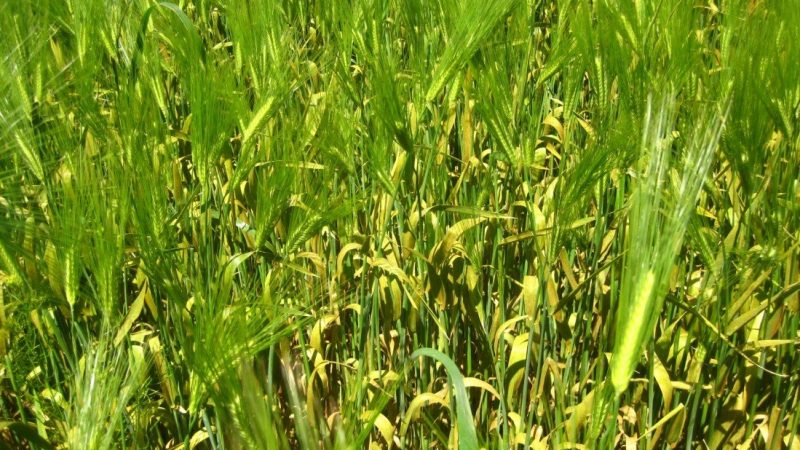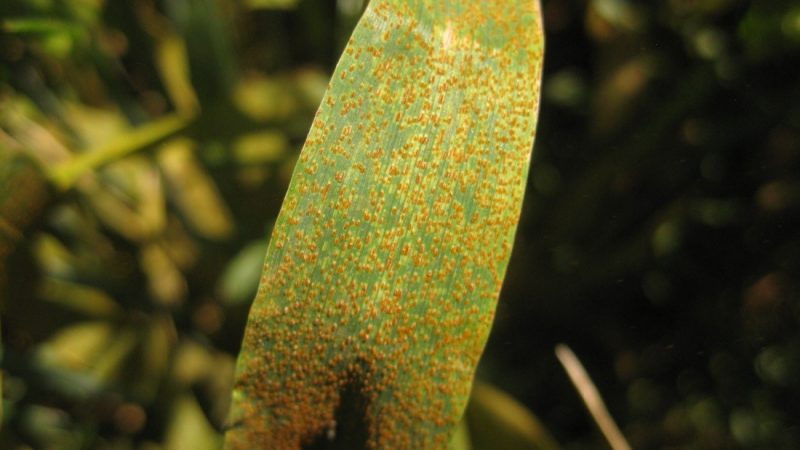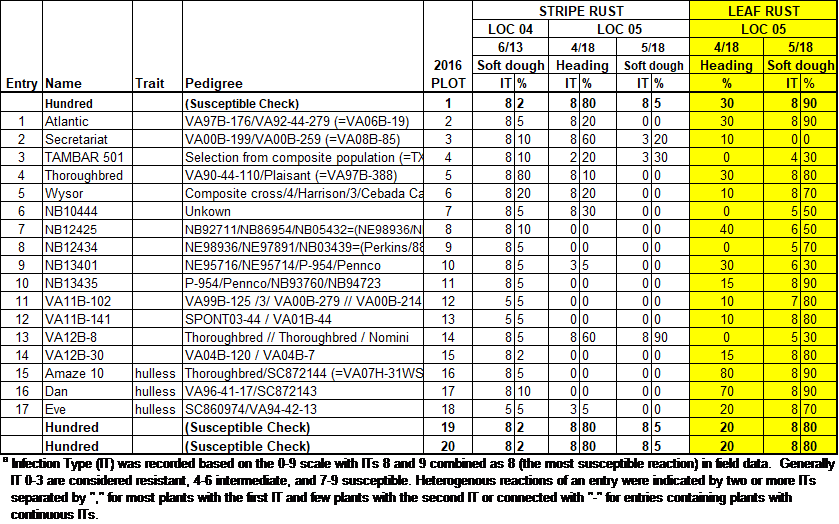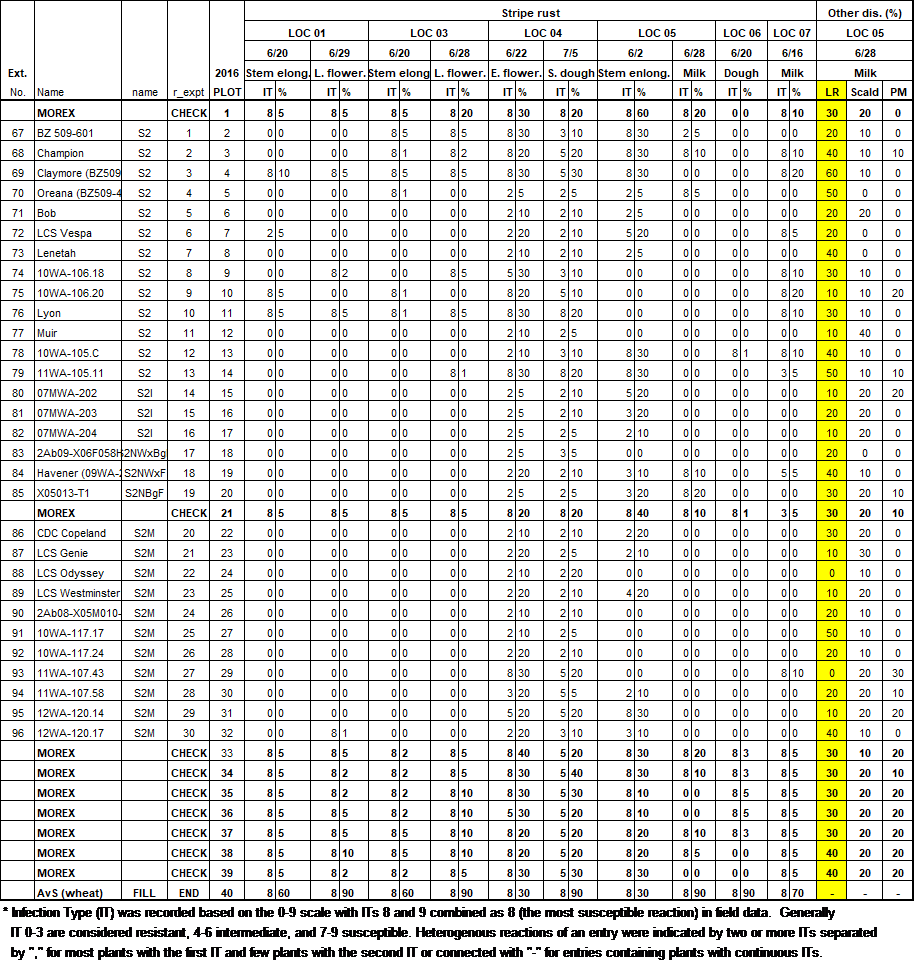Xianming Chen
This update reports:
- Barley leaf rust first find in the east of the Cascade Mountain range in the PNW,
- Barley stripe rust, and
- Wheat stripe rust, including data of the 2017 Winter Wheat Variety Trials at Walla Walla for reference of control stripe rust in the PNW.
-
Barley Leaf Rust
Barley leaf rust (caused by Puccinia hordei) was found in a couple of fields planted with facultative winter barley variety ‘Maja’ in Walla Walla County, Washington near the Oregon border. By yesterday, rust incidence was 100% and severity ranged from 40 to 100% (Figures 1 and 2). According to the grower, the fields were planted in last October and rust started appearing more than a month ago, but due to organic farming, the fields could not be applied with fungicides. He plans to cut the crops these days.
To my knowledge, this is the first observed barley leaf rust in the area east of the Cascade Mountain range in the Pacific Northwest (PNW). Before this occurrence, barley leaf rust had only been observed in the west of the mountain range. For example, the disease usually shows up in our nurseries in Mount Vernon (Skagit Co, WA) in late season as most barley varieties in production and nurseries are most spring barley. In the recent years, barley leaf rust has increased severity, which has interfered with our screening for barley stripe rust. By the first week of May this year, we did not see leaf rust on barley in Mount Vernon. According to Dr. Patrick Hayes, barley breeder at Oregon State University, leaf rust has not observed in barley nurseries at Corvallis, OR this year. In the winter barley fields in Walla Walla, the crops are headed. It is apparent that infection occurred last fall and the fungus well overwintered due to snow cover. The rust inoculum was likely from western Oregon and/or western Washington last year. In 2016, the grower grew two crops in one of his fields about several hundred meters west of this year’s fields. The first crop was harvested in June and the second crop of the same Maja variety was planted in July and harvested in November. He did not see rust in the first crop, but noticed rust in the second crop. Spores from this field were likely blown to and infected the fields planted last October.
Most barley varieties in our nurseries in Mount Vernon in the recent years were susceptible to leaf rust. I include our last year data of two of the barley nurseries for your information (Table 1 and Table 2). If you grow winter or spring barley for non-organic production, please check fields. If you see leaf rust, consider applying fungicides. The popular fungicides which are used to control stripe rust and other foliar fungal diseases on cereal crops should control leaf rust. As leaf rust has not become a common disease in the barley production areas in the PNW, a big gap between barley crops may break the disease cycle. It will be better to avoid growing winter barley and spring (or summer) barley crops continually in the same area.

Figure 1. Leaf rust in a winter barley field in Walla Walla County, WA (May 18, 2017)

Figure 2. Barley leaf rust (May 18, 2017)

Table 1. Leaf rust and stripe rust data of the Eastern US Winter Barley Nursery tested at Mount Vernon, WA in 2016. (IT=infection type and % = rust severity)

Table 2. Leaf rust and stripe rust data of the WSU Spring Barley Variety Trial Nursery tested at Mount Vernon, WA in 2016. (IT=infection type and % = rust severity)
-
Barley Stripe Rust
Barley stripe rust has been found on winter barley in our nurseries in Mount Vernon, Lind, and Walla Walla at low levels. Steve Jone’s group has also found stripe rust in their winter barley nurseries in Mount Vernon. We have received barley stripe rust samples from inoculated fields in California. The disease pressure of barley stripe rust is much lower than wheat stripe rust. However, with the rust-favorable weather conditions, barley stripe rust has potential to become significant, similar to or higher than the situations last year. Check barley fields for stripe rust (and also for leaf rust), apply fungicides when the rust level is low, but is easily to find (5% incidence).
-
Wheat Stripe Rust
When we were checking fields yesterday, stripe rust reached 100% severity on susceptible varieties in Walla Walla and 90% in Lind in our nurseries. In commercial fields, stripe rust was generally under control in Umatilla County, OR close to the Washington border; Walla Walla, Columbia, Garfield, and Asotin counties of Washington; and Nez Perce and Latah counties of Idaho due to resistance and/or fungicide application. Few fields in Garfield County had visible stripe rust foci.
As the weather has been and will continue to be favorable for stripe rust development, we still have a long way to go to control stripe rust for this crop season. Check fields for active stripe rust pustules and apply fungicides as needed. I attach stripe rust data of the winter wheat variety trials from our Walla Walla nursery for reference (Table 3). Varieties with ratings 4 and higher may need fungicide application; and those with ratings 1 to 3 generally do not need fungicide application. However, if active rust pustules are quite common (5% incidence), consider using fungicides.
Since the last update (May 5), stripe rust has been reported in Montana and Colorado, in addition to the previous reports in Texas, Louisiana, Arkansas, Mississippi, North Carolina, Oklahoma, Kansas, Washington, Oregon, Wisconsin, Virginia, Delaware, Tennessee, Michigan, Kentucky, Nebraska, Indiana, Georgia, Idaho, Arizona, and California of the US and Alberta and Ontario of Canada.
Table 3. Stripe rust data of the 2017 WSU Winter Wheat Variety Trials at Walla Walla
| Walla Walla | ||||||
|---|---|---|---|---|---|---|
| 4/19/2017 | 5/18/2017 | |||||
| 2017 | Feekes 6 | Feekes 9-10.2 | ||||
| Variety name | PLOT | IT | % | IT | % | Rating |
| LCS Colonia | 1 | 2 | 5 | 2 | 2 | 1 |
| LCS Jet | 2 | 5 | 5 | 2 | 5 | 1 |
| LWW14-73915 | 3 | 2 | 5 | 2 | 2 | 1 |
| Keldin | 4 | 5 | 5 | 3 | 30 | 3 |
| WB4623CLP | 5 | 5 | 10 | 2 | 10 | 2 |
| WB-Arrowhead | 6 | 2 | 2 | 2 | 5 | 1 |
| XA4103 | 7 | 2 | 5 | 2 | 10 | 2 |
| XA4104 | 8 | 5 | 5 | 3 | 15 | 2 |
| SY Clearstone CL2 | 9 | 5 | 15 | 5 | 30 | 4 |
| SY Touchstone | 10 | 2 | 10 | 2 | 10 | 2 |
| Whetstone | 11 | 6 | 20 | 2 | 15 | 2 |
| Mandala | 12 | 7 | 20 | 3 | 20 | 3 |
| AP503 CL2 | 13 | 8 | 15 | 3 | 20 | 3 |
| Farnum | 14 | 8 | 20 | 2 | 5 | 1 |
| Sequoia (WA 8180) | 15 | 5 | 5 | 3 | 15 | 2 |
| WA 8247 | 16 | 6 | 30 | 3 | 20 | 3 |
| WA 8272 | 17 | 5 | 10 | 2 | 2 | 1 |
| WA 8273 | 18 | 5 | 15 | 2 | 2 | 1 |
| LCS Aymeric | 19 | 4 | 5 | 2 | 2 | 1 |
| NSA10-2196 | 20 | 5 | 5 | 2 | 5 | 1 |
| PS279 CHECK | 21 | 8 | 80 | 8 | 100 | 9 |
| Norwest 553 | 22 | 2 | 20 | 2 | 5 | 1 |
| WA 8248 | 23 | 2 | 2 | 2 | 5 | 1 |
| WA 8268 | 24 | 2 | 2 | 2 | 2 | 1 |
| WA 8269 | 25 | 2 | 5 | 2 | 2 | 1 |
| LCS Evina | 26 | 2 | 10 | 2 | 2 | 1 |
| Metropolis | 27 | 5 | 20 | 2 | 2 | 1 |
| Rebelde | 28 | 2 | 15 | 3 | 20 | 3 |
| KWS 145 | 29 | 6 | 15 | 2 | 5 | 1 |
| LWW14-73163 | 30 | 4 | 20 | 3 | 10 | 2 |
| Norwest Duet (LOR-092) | 31 | 5 | 5 | 3 | 10 | 2 |
| Mary | 32 | 5,8 | 10,10 | 2 | 5 | 1 |
| Norwest Tandem (LOR-334) | 33 | 5 | 5 | 5 | 40 | 5 |
| OR2121086 | 34 | 5 | 2 | 2 | 5 | 1 |
| ORCF-102 | 35 | 5 | 5 | 2 | 5 | 1 |
| ORI2150031 CF+ | 36 | 5 | 2 | 8 | 30 | 6 |
| Legion | 37 | 5 | 5 | 2 | 5 | 1 |
| SY 107 | 38 | 5 | 40 | 2 | 5 | 1 |
| IDN 06-03303B | 39 | 5 | 10 | 3 | 30 | 3 |
| IDN 07-28017B | 40 | 5 | 10 | 2 | 5 | 1 |
| PS279 CHECK | 41 | 8 | 90 | 8 | 100 | 9 |
| IDN 09-15702A | 42 | 3 | 2 | 2 | 5 | 1 |
| UI Castle CL+ | 43 | 8 | 5 | 5 | 20 | 4 |
| UI Magic CL+ | 44 | 5 | 15 | 3 | 20 | 3 |
| UI Sparrow (IDO1108DH) | 45 | 2 | 10 | 2 | 5 | 1 |
| ARS-Crescent | 46 | 6 | 60 | 3 | 30 | 3 |
| WB1376CLP | 47 | 2 | 10 | 2 | 10 | 2 |
| WB1529 | 48 | 5 | 15 | 2 | 10 | 2 |
| WB1604 | 49 | 5 | 5 | 2 | 5 | 1 |
| XA1101 CL+ | 50 | 2 | 5 | 2 | 2 | 1 |
| XA1401 CL+ | 51 | 2 | 10 | 2 | 5 | 1 |
| WB1783 | 52 | 5 | 5 | 3 | 10 | 2 |
| Jasper | 53 | 5 | 10 | 2 | 10 | 2 |
| KXB-01 | 54 | 5 | 20 | 3 | 20 | 3 |
| Puma | 55 | 5 | 20 | 3 | 20 | 3 |
| Xerpha | 56 | 8 | 50 | 8 | 60 | 8 |
| LWW14-73161 | 57 | 5 | 15 | 2 | 10 | 2 |
| LWW14-74143 | 58 | 5 | 10 | 2 | 10 | 2 |
| ORCF-103 | 59 | 8 | 50 | 8 | 80 | 8 |
| SY 04PN066-7 | 60 | 6 | 30 | 2 | 10 | 1 |
| PS279 CHECK | 61 | 8 | 90 | 8 | 100 | 9 |
| SY 09PN005#25 | 62 | 5 | 15 | 2 | 10 | 2 |
| WA 8276 | 63 | 2 | 10 | 2 | 5 | 1 |
| ARS20060123-31C | 64 | 5 | 20 | 3 | 30 | 3 |
| ARSDH08028-111C | 65 | 2 | 20 | 2 | 5 | 1 |
| Coda | 66 | 5 | 15 | 2 | 15 | 2 |
| Pritchett (4J0713366C) | 67 | 5 | 10 | 3 | 20 | 3 |
| WB1843 | 68 | 5 | 40 | 5 | 30 | 4 |
| Bruehl | 69 | 5 | 20 | 3 | 15 | 2 |
| Curiosity CL+ | 70 | 5 | 20 | 3 | 15 | 2 |
| Eltan | 71 | 5 | 40 | 5 | 30 | 4 |
| Masami | 72 | 2 | 30 | 2 | 10 | 2 |
| Mela CL+ | 73 | 5 | 25 | 3 | 20 | 3 |
| Otto | 74 | 5 | 25 | 3 | 20 | 3 |
| WA 8226 | 75 | 2 | 10 | 2 | 10 | 2 |
| WA 8227 | 76 | 2 | 10 | 2 | 5 | 1 |
| WA 8270 | 77 | 5 | 30 | 3 | 15 | 2 |
| WA 8271 | 78 | 5 | 40 | 3 | 15 | 2 |
| LCS Artdeco | 79 | 5 | 50 | 3 | 20 | 3 |
| LCS Drive (LWW12-7105) | 80 | 2 | 15 | 2 | 5 | 1 |
| PS279 CHECK | 81 | 8 | 90 | 8 | 100 | 9 |
| LWW14-71195 | 82 | 5 | 20 | 2 | 10 | 2 |
| LWW14-72916 | 83 | 2 | 5 | 2 | 10 | 2 |
| Bobtail | 84 | 2 | 5 | 2 | 5 | 1 |
| OR2101043 | 85 | 2 | 5 | 2 | 5 | 1 |
| Rosalyn | 86 | 5 | 15 | 3 | 15 | 2 |
| SY 09PN062#18 | 87 | 4 | 10 | 2 | 10 | 2 |
| Brundage 96 | 88 | 5 | 20 | 3 | 20 | 3 |
| SY 46#16 | 89 | 5 | 15 | 2 | 15 | 2 |
| WA 8274 CL+ | 90 | 5 | 10 | 3 | 20 | 3 |
| SY Assure | 91 | 5 | 5 | 2 | 10 | 2 |
| SY Ovation | 92 | 5 | 20 | 2 | 15 | 2 |
| UI Palouse CL+ | 93 | 5 | 15 | 3 | 25 | 3 |
| UI-WSU Huffman | 94 | 2 | 5 | 2 | 10 | 2 |
| ARS20040150-2C | 95 | 2 | 5 | 2 | 5 | 1 |
| ARSDH08028-44C | 96 | 2 | 5 | 5 | 10 | 3 |
| ARS-Selbu | 97 | 5 | 2 | 2 | 10 | 2 |
| Cara | 98 | 2 | 5 | 2 | 2 | 1 |
| Madsen | 99 | 5 | 2 | 3 | 10 | 2 |
| WB 456 | 100 | 5 | 5 | 3 | 10 | 2 |
| PS279 CHECK | 101 | 8 | 90 | 8 | 90 | 9 |
| WB-528 | 102 | 5 | 30 | 2 | 10 | 2 |
| WA 8187 | 103 | 2 | 10 | 2 | 5 | 1 |
| YS-206 | 104 | 5 | 10 | 2 | 5 | 1 |
| WA 8245 | 105 | 5 | 15 | 3 | 15 | 2 |
| WA 8232 | 106 | 5 | 10 | 2 | 10 | 2 |
| WA 8234 | 107 | 4 | 5 | 2 | 5 | 1 |
| LCS Biancor | 108 | 2 | 5 | 2 | 5 | 1 |
| IDN 01-10704A | 109 | 2 | 5 | 3 | 10 | 2 |
| IDN 02-29001A | 110 | 3 | 2 | 2 | 2 | 1 |
| PS279 CHECK | 111 | 8 | 80 | 8 | 100 | 9 |